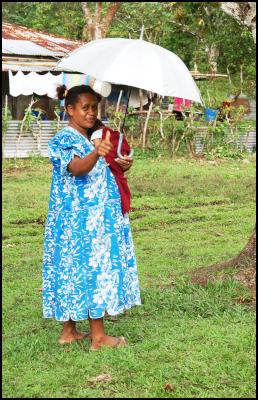Communities Must Be First To React To A Disaster
Communities Must Be First To React To A Disaster
By Mari Moertvedt

An umbrella to protect against rain, but are the community protected against natural hazards?
“Normally after a cyclone there is more rain, so if a person gets hurt or sick during the cyclone this person have to wait inside for maybe one or two weeks. When the rain stops he or she has to go to our closest hospital in Lolovai, which is two hours walk away,” Mr. Edison Tari from Tagui village on Ambae island in Vanuatu explains.
Every year the Tagui village experience cyclones and problems of getting enough safe drinking water. Their population is 170 people divided on 30 households and their only way of transportation is by foot or by paying to use the one driver in the area. He is not always available and the bumpy road to the village gets too damaged to use when there is heavy rain.
Vulnerable position
“Vanuatu has many communities and villages in very remote areas. If a disaster hits these places, it is impossible for national and international aid to reach them fast enough. Lives may be lost, which is why a tailored disaster risk management plan is important to highlight the issues of each specific village,” Mr. Sunil Gurung, United Nations Volunteer and Disaster Risk Management specialist, says.
Tagui village is one of two villages on Ambae which is part of a project called Building Resilient Communities towards Effective Governance (BRCTG). It is funded by the United Nations Development Program (UNDP) in partnership with the government of Vanuatu. Technical assistance is delivered by United Nations Volunteers (UNV). The two villages, Tagui in the North and Lolovoli in the South, will be given assistance to develop their own disaster risk management plan.
“This plan will help the community to be better prepared to meet a disaster. We hear a lot about recovery after an earthquake, a tsunami or a cyclone, but little about prevention and mitigation. These two villages are part of this pilot project, but my opinion is that every village should have a similar plan to be able to cope with disasters”, Mr. Gurung says.
Traditional ways
“The girls in the family have some responsibility that we normally do in the village. We have to prepare food and make sure that we have enough drinking water. The men are doing the heavier job like getting firewood and strengthen the house”, Ms. Clerah Tari says.
The community are used to prepare for cyclones. They know that the season start in November and they prepare with and without a cyclone warning, as they have experienced how much damage this natural hazard can create.
“We were hit very badly by the Nigel hurricane in 1985. Many of our houses fell and all our kitchens were damaged. Our gardens got destroyed and we lost many animals. The threes were left with no leaves, which also showed the strength of the hurricane,” Gloria Tari adds.
The village has learned from this experience and they are now trying to make their houses stronger and more capable of coping with future cyclones, but they need help from the outside to build a better road for potential evacuation and enough water to make it through isolation.
“The disaster risk management plan will identify what their needs are and it will also include how they can approach local authorities and international donors to get assistance,” Mr. Godfrey Darubi, planner in the Penama province, says.
Young girl in nurse training
“The project has helped us create a disaster risk management committee of nine people and they will be in charge of making our disaster plan. We think it is good that someone will be responsible for this in the village,” Mr. Edison Tari says.
He explains that the village needs an aid post closer to their home, because the hospital is very far away. Through this project they were given the idea to send a girl from the village for training, so she can assist if the villagers have health issues.
“We are happy, because one girl from this village is in nurse training in Port Vila. This might save several villages around here and it will cut the cost of walking, time and money we have to spend to go to Lolovai hospital”, Mr. Tari adds.
“In this project we are not able to give direct aid to build stronger houses or provide water tanks, but through workshops and conversations we are able to educate the communities and give them ideas on how they themselves can cope with their natural hazards. This is a way of ensuring sustainable development and we hope that other villages will look to Tagui and Lolovoli and develop their own community disaster risk plan,” Mr. Gurung ends.

Tagui Children
ENDS


 Stefan Wolff & Tetyana Malyarenko, The Conversation: Raised Voices And Angry Scenes At The White House As Trump Clashes With Zelensky Over The ‘Minerals Deal’
Stefan Wolff & Tetyana Malyarenko, The Conversation: Raised Voices And Angry Scenes At The White House As Trump Clashes With Zelensky Over The ‘Minerals Deal’ UN Treaty Bodies: Fair And Effective Tax Policies Needed To Advance Economic, Social And Cultural Rights And Equality, UN Committee Says
UN Treaty Bodies: Fair And Effective Tax Policies Needed To Advance Economic, Social And Cultural Rights And Equality, UN Committee Says John P. Ruehl, IMI: The Coming Age Of Border Changes?
John P. Ruehl, IMI: The Coming Age Of Border Changes? CNS: With Only 70 Months Left To End AIDS Why Is The Urgency Missing?
CNS: With Only 70 Months Left To End AIDS Why Is The Urgency Missing? WHO: WHO Marks 20 Years Of Its Lifesaving Tobacco Control Treaty
WHO: WHO Marks 20 Years Of Its Lifesaving Tobacco Control Treaty Sony World Photography Awards: Professional Competition - Finalists & Shortlists Announced
Sony World Photography Awards: Professional Competition - Finalists & Shortlists Announced